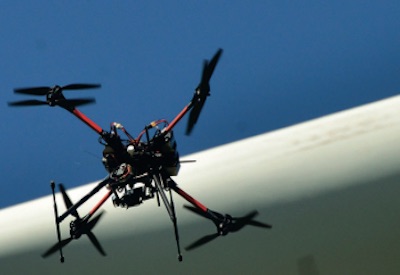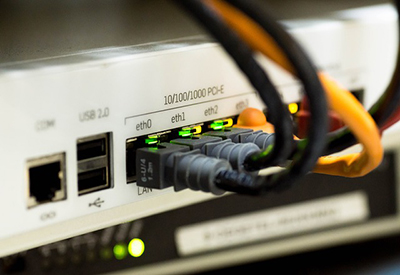Using Drones to Inspect Wind Turbines

Jan 29, 2019
At a time when wind power is expanding rapidly, blade inspections are becoming a crucial maintenance activity. Although a number of inspection methods exist, new drone-based technologies are increasingly appealing. A recent study conducted by Nergica provides an overview of the inspection market and the needs of the sector, and presents existing as well as up-and-coming solutions such as drone-based inspections and the automation of the various stages of inspection and diagnostics. Key findings from the report are summarized here.
Certain technical and legislative factors must be taken into account to guarantee the effectiveness of the inspection and the validity of the data gathered at the time. Such factors notably include:
• the selection of sensors and a camera capable of providing satisfactory resolution
• optimization of the flight plan
• the expertise in composites necessary to identify and prioritize defects
• use of a software or expert system capable of producing diagnostic reports that will help operators make informed O&M decisions with regard to their turbines
Recent technological advances are now allowing operators to entertain the prospect of increasingly complete automation of inspections and diagnostics as a solution for the future. However, automation raises a number of questions in terms of both technologies and legislation. Each of these questions in turn translates into a challenge that helps drive the applied research sector.
Full automation of the blade inspection process implies the use of a drone that operates completely independently of a pilot. The self- guided drone thus flies according to a program and a pre-established trajectory and then, once the images have been analyzed, generates an automatic report.
Automation raises interesting questions in terms of both technological development and the adaptation of applicable regulations. For example, will Canadian standards evolve to the point that drones will one day be able to fly without constant surveillance? What about image analysis? Will automation of the latter help facilitate reliable diagnosis of the condition of blades at a wind farm?
Regardless of these questions, automation will invariably coincide with the development of advanced flight technologies, image analysis and diagnostics routines, defect codification and the generation of a report that can be used to make informed O&M decisions. These conditions call for numerous advances in the field of computer science, the development of sufficiently powerful batteries and increasingly accurate sensors, state-of-the-art computers capable of processing significant quantities of data and generating reports and documented track records. In other words, drones represent a solution that, although beginning to gain traction, still present a few interesting challenges for companies and research centres.
Why drones?
Although the various manual inspection methods employed to date are sufficient to identify and characterize a number of different blade defects, they remain costly and time consuming. Some of these methods, such as rope-access inspection for example, entail certain safety risks for workers.
However, the use of remote drone-assisted inspection methods — although they are more flexible, faster, less costly and safer — can limit the number of defects identified per inspection or compromise their classification. Despite these constraints, drone-based inspections do offer undeniable advantages. In fact, studies conducted together with various industrial partners have demonstrated that remote inspection methods using drones have the advantage of providing rapid and low-cost insight into the scale and distribution of blade defects present at a given wind farm.
Although drones do not offer the same degree of accuracy as other techniques, it is generally agreed that they allow a greater number of blades to be inspected in a given amount of time while limiting direct interventions to those blades that require repairs. In this regard, the use of drones represents an advance that may be poised to revolutionize the field of inspections.
Potential of drone-based inspections
Results from certain experiments show that a blade surface inspection could be completed in slightly less than 15 minutes. Consequently, it would be theoretically possible to inspect three blades in 45 minutes. However, this figure does not include the time needed to change the drone battery or turn the rotor, which according to some estimates can be completed in approximately 30 minutes, or in 15 minutes if both tasks are performed in parallel.
If one assumes that inspection requires 75 minutes and that it takes 15 minutes to move from one turbine to the next, it seems realistic to allow 1.5 hours (in favourable conditions) to complete the comprehensive inspection of all blades of a single turbine, whereas the same work performed using rope-access techniques generally requires much more time.
Based on the assumptions and the example presented above, the use of drones, even if employed only for a visual inspection of defects, is approximately five times faster than inspections using rope-access techniques. In other words, with drones, slightly more than five wind turbines can be inspected in the same time span as would be required to inspect a single machine using rope access. Furthermore, if the production losses stemming from the stoppage of turbines during the inspection work are taken into account, using drones can offer a clear advantage for wind farm operators.
Drone inspections also show highly promising potential to take maximum advantage of favourable periods for summer inspections.
Key elements of drone inspections
Although drone inspections may initially seem to be a promising solution for a number of operators, certain technical and legislative factors must be taken into consideration to guarantee the effectiveness of the inspection and the validity of the data gathered at the time thereof.
Beyond the tool itself, drone-based inspections require the use of special sensors, flight plans that take multiple factors into consideration and, lastly, proven expertise in wind power, composites and characterizing the defects and damage identified on the blades. They must also comply with all applicable regulations.
Conclusion
In light of the prospects for growth in renewable energy integration, the wind industry is shifting, and rightfully so, toward advanced solutions to optimize project productivity in a cost-competitive manner. O&M activities are also part of this trend and are forcing the inspection market to offer innovative solutions to overcome the challenges associated with inspecting operational turbines.
Although the use of drones to inspect wind turbines is a relatively recent development, it represents clear advantages to perform more economical diagnostics that can contribute to informed mainte- nance-related decisions. In this context, this promising solution warrants further research and in situ validation of these new technologies.
This article has been adapted from a document first published online by Nergica.
Nergica is a centre of applied research that stimulates innovation in the renewable energy industry through research, technical assistance, technology transfer and technical support for businesses and communities. Its mission: creating new opportunities for renewable energy. Nergica also offers advanced services for the development and assessment of new technologies, commercialization of innovations, adapted meteorology, microgrids, energy storage and grid management. Initially known as the TechnoCentre éolien when it was founded in 2000, Nergica is an official college centre for technology transfer (CCTT) and is affiliated with the Cégep de la Gaspésie et des Îles.

















